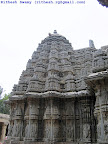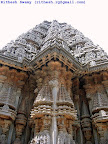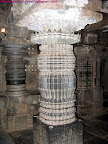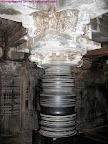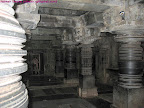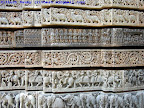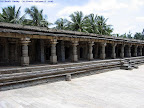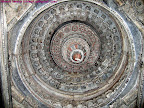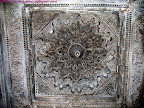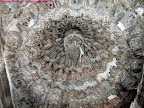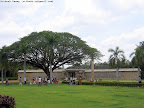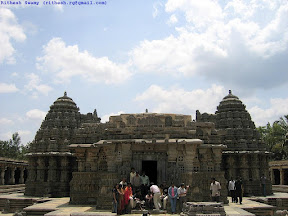 |
| From Somnathapura |
Somanathapura around 40 KM from
This fine example of Hoysala architecture is dedicated to Lord Keshava. It also houses sanctums of Lord Venugopala and Janardhana.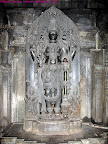

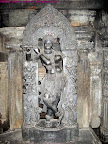
Like most Hoysala monuments Somanathpura temple is star shaped – this design is followed by most Hoysala temples to increase the surface area of the temple.
The three shines or the sanctums (Thrikuta design) are identical in design and is built on an elevated platform. The pillars inside the temple are in itself a marvel.
Another feature that this temple shares with the other 2 temples is the bands of intricately carved figures running all around the outer walls. The lowest band contains images of elephants in different postures. The elephant signifies strength and they are supposed to support the temple on them. The next band contains images of horses, again in various postures. Other bands contained various animals and idols and complex patterns, telling us the stories form Ramayana, Mahabharata and other Puranas.
The Father of Hoysala architecture was Amarashilpi Jakanacharya. Jakanacharya was the chief architect of both Belur and Halebidu both of which were built in early 11th century. However the temple at Somanathpura was built only in mid 12th century using most of his ideas.
The temple like the other two temples is carved out of soap stone (technical name - dark grey green chloritic schist). This stone when freshly quarried is soft and easy to work on, however with time they become hard.
I was surprised to see that pooja was not performed in this temple. Same is the case with the temple at Halebidu. The idol at Halebidu and the temple was damaged by a Muslim ruler Malik Kafur. The original idol of Lord Kesava of Somanathpura is currently in a british museum. Only a replica of the original idol is present here. Also the idols in the 64 cells
around the main temple were either taken away by the british or have been damaged. According to Hindu mythology once the main idol of the temple is damaged, no longer is the pooja offered at the temple. I am not sure if the poojas still take place at the Belu temple. It’s a pity that we have lost such precious souvenir of ancient
Another wonder to watch in the temple are the ceilings. It’s truly marvelous. I tried my best to capture it on my cam, but being an amateur photographer didn’t help.
One can also observer that the ceilings were painted, I am not sure if these are the original paintings or done latter. My guess is they are the original paintings. However the rain water seeping in through the ceiling has damaged these paintings. I am surprised the ASI hasn’t done anything to stop this. But over all ASI is doing a pretty good job in
maintaining the temple. Absence of the poojas and an entry fee to the temple has certainly help.
I would consider this temple the grandest and the best among the 3 main Hoysala temples. This temple stands testimony to the fact that Karnataka is the cradle of stone architecture in

